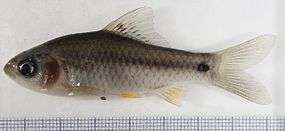Puntius
| Puntius | |
|---|---|
 | |
| Puntius chola | |
| Scientific classification | |
| Kingdom: | Animalia |
| Phylum: | Chordata |
| Class: | Actinopterygii |
| Order: | Cypriniformes |
| Family: | Cyprinidae |
| Genus: | Puntius F. Hamilton, 1822 |
| Type species | |
| Cyprinus sophore F. Hamilton, 1822 | |
Puntius is a genus of fish in the family Cyprinidae native to South Asia and Mainland Southeast Asia.[1] Many species have been moved to other genera such as Barbodes and Sahyadria.[2][3][4] The greatest species richness is in India. The maximum size for an adult of this genus is less than 25 cm (9.8 in), typically 7–15 cm (2.8–5.9 in) and many species only achieve around 5 cm (2.0 in) adult length. In appearance they may resemble miniature carp and are often brightly coloured or patterned. These fishes are omnivorous; their diet includes small invertebrates and plant matter. Breeding is by egg scattering and takes place close to the bottom, near or within areas of dense plant growth. They do not show parental care and adults may eat the young. The name Puntius comes from pungti, a Bengali term for small cyprinids.
Taxonomy
Historically, many species of Puntius have been classified in several genera, including Barbus. Despite the reclassifications, the specific epithet remains the same in these – except in cases of homonymies – as Barbus and Puntius have the same grammatical gender. The closest living relatives of the spotted barbs are the genus Cyprinion and perhaps the genus Capoeta. These and the other "typical" barbs and barbels were formerly often separated as subfamily Barbinae, but this group is highly paraphyletic with regard to the Cyprininae and better merged there at least for the largest part (including Puntius). In particular the genus Barbonymus, containing the tinfoil barb and its relatives – for some time included in Puntius – appears to be a kind of carp that has evolved convergently with barbs.
Species
There are currently 42 recognized species in this genus:
- Puntius ambassis (F. Day, 1869)
- Puntius amphibius (Valenciennes, 1842) (Scarlet-banded barb)
- Puntius arenatus (F. Day, 1878)
- Puntius bimaculatus (Bleeker, 1863) (Red-side barb)
- Puntius brevis (Bleeker, 1849)
- Puntius burmanicus (F. Day, 1878)
- Puntius cauveriensis (Hora, 1937)
- Puntius chola (F. Hamilton, 1822) (Swamp barb)
- Puntius crescentus G. M. Yazdani & D. F. Singh, 1994
- Puntius deccanensis G. M. Yazdani & M. Babu Rao, 1976 (Deccan barb)
- Puntius dolichopterus Plamoottil, 2015 [5]
- Puntius dorsalis (Jerdon, 1849) (Long-snouted barb)
- Puntius euspilurus Plamoottil, 2016 [6]
- Puntius fraseri (Hora & Misra, 1938) (Dharna barb)
- Puntius kamalika N. K. A. Silva, Maduwage & Pethiyagoda, 2008
- Puntius kelumi Pethiyagoda, N. K. A. Silva, Maduwage & Meegaskumbura, 2008
- Puntius khohi Dobriyal, R. Singh, S. P. Uniyal, H. K. Joshi, S. Phurailatpam & M. S. Bisht, 2004
- Puntius layardi (Günther, 1868)
- Puntius madhusoodani Krishna Kumar, Benno Pereira & Radhakrishnan, 2012 [7]
- Puntius mahecola (Valenciennes, 1844)
- Puntius masyai H. M. Smith, 1945
- Puntius mudumalaiensis Menon & Rema Devi, 1992
- Puntius muzaffarpurensis Srivastava, K. P. Verma & R. B. Sharma, 1977
- Puntius nangalensis Jayaram, 1990
- Puntius nelsoni Plamoottil, 2014 [8]
- Puntius nigronotus Plamoottil, 2014 [9]
- Puntius parrah F. Day, 1865
- Puntius paucimaculatus Y. H. Wang & Y. Ni, 1982
- Puntius pugio S. O. Kullander, 2008
- Puntius punjabensis (F. Day, 1871)
- Puntius puntio (F. Hamilton, 1822)
- Puntius sahyadriensis Silas, 1953 (Khavli barb)
- Puntius schanicus (Boulenger, 1893)
- Puntius snyderi Ōshima, 1919
- Puntius sophore (F. Hamilton, 1822) (Pool barb)
- Puntius sophoroides (Günther, 1868)
- Puntius stigma (Valenciennes, 1844) [8]
- Puntius terio (F. Hamilton, 1822) (One-spot barb)
- Puntius titteya Deraniyagala, 1929 (Cherry barb)
- Puntius viridis Plamoottil & Abraham, 2014 [10]
- Puntius vittatus F. Day, 1865 (Green-stripe barb)
- Puntius waageni (F. Day, 1872)
References
| Wikimedia Commons has media related to Puntius. |
- ↑ Froese, Rainer, and Daniel Pauly, eds. (2016). Species of Puntius in FishBase. June 2016 version.
- ↑ Kottelat, M. (2013): The fishes of the inland waters of southeast Asia: A catalogue and core bibliography of the fishes known to occur in freshwaters, mangroves and estuaries. Raffles Bulletin of Zoology, Suppl. No. 27: 1–663.
- ↑ Pethiyagoda, R., Meegaskumbura, M. & Maduwage, K. (2012): A synopsis of the South Asian fishes referred to Puntius (Pisces: Cyprinidae). Ichthyological Exploration of Freshwaters, 23 (1): 69–95.
- ↑ Raghavan, R., Philip, S., Ali, A. & Dahanukar, N. (2013): Sahyadria, a new genus of barbs (Teleostei: Cyprinidae) from Western Ghats of India. Journal of Threatened Taxa, 5 (15): 4932–4938.
- ↑ Plamoottil, M. (2015): Puntius dolichopterus, a new fish species (Cypriniformes: Cyprinidae), from Kerala, India. International Journal of Pure and Applied Zoology, 3 (3): 226–231.
- ↑ Plamoottil, M. (2016): Puntius euspilurus, a new fish species (Cypriniformes: Cyprinidae) from Kerala, India. International Journal of Research Studies in Biosciences, 4 (9): 1-6.
- ↑ Krishna Kumar, K., Benno Pereira, F.G. & Radhakrishnan, K.V. (2012): Puntius madhusoodani (Teleostei: Cyprinidae), a new species of barb from Manimala River, Kerala, South India. Biosystematica, 5 (2): 31-37.
- 1 2 Plamoottil, M. (2014): Puntius nelsoni, Systomus chryseus and S. rufus (Cypriniformes: Cyprinidae), three new fish species from Kerala, India. International Journal of Fauna and Biological Studies, 1 (6): 135–145.
- ↑ Plamoottil, M. (2014): Puntius nigronotus, a new fish species (Cypriniformes; Cyprinidae) from Kerala, India. Journal of Research in Biology, 4 (8): 1581–1588.
- ↑ Plamoottil, M. & Abraham, N.P. (2014): Puntius viridis (Cypriniformes, Cyprinidae), a new fish species from Kerala, India. Journal of Research in Biology, 3 (7): 1093–1104.